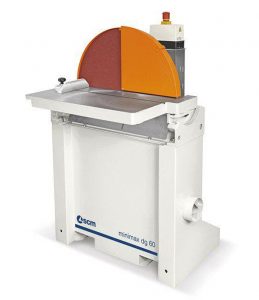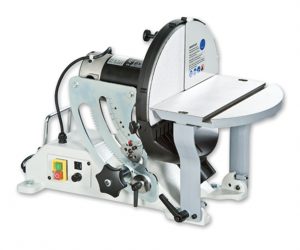- Large: Minimax DG60 Small: Axminster SS-12VS
- Timber, Manufactured Board, Plastic and Styrofoam
- Sanding
- Workshop Category: W3
- Workshop Risk Category: Orange: Medium Risk


The disc sanders are for surface or edge sanding of non-metallic materials only. The safety concepts presented are the same for any size machine.
Start with a Risk Assessment to ensure a safe work area:
- Only trained operators (completed online Induction and sign off by workshop manager) can use either disc
sander - The area around the disc sander must be kept clear of people, debris and sawdust
- Safety glasses or a face shield must be worn. Wear a P3 mask if sanding for extended periods of time (over 30minutes)
- Remove loose fitting clothing, jewellery, and tie back long hair.
- Familiarise yourself with the off and on button.
- A sanding disc will cut material very quickly, failure to anticipate this may cause injury to the finger and hands
- Turn on LEV and open the blast gate. The air flow must not be less than 1500 Pa
- Check the integrity of the disc. Any ripped discs must be reported to the workshop manager
- Do not wear gloves while operating the sander
Operational Safety Rules:
- Approach your work in the workshop and on the Disc Sander with a safe attitude.
- Ensure that the gap between the sander table and the moving disc is kept as small as possible but does not restricted the disc turning
- The distance between your fingertips and the moving disc or belt shall be no closer than 8cm.
- Do not sand pieces of material that are too small to be safely supported
- Always hold the work firmly when sanding
- Use the fence, table or other supports when sanding
- Always hold the work firmly on the downward rotation side of the table
- Avoid awkward hand positions where a sudden slip could cause a hand to move into the sanding disc
- Do not sand with the work piece unsupported. Support the work piece with the backstop or table
- Always remove scrap pieces and other objects from the table before turning the machine on
- Allow the machine to reach full speed before feeding material. Similarly, it takes time for the disc or belt to stop moving. Small Disc Sander: Use the break after switching off the machine to bring the disc to a stop
- Do not push hard on the sanding media. The sander performs best and safest when it is allowed to remove material at the rate for which it was designed
- Sanding wood or plastic will cause heat build-up due to friction and may cause the wood to burn and the plastic to melt rapidly
- Never adjust the table angle while the sander is running
- Always turn the machine off and disconnect the power cord before installing or removing discs or when making repairs
- Never leave the machine work area when the machine is running or before the machine has come to a complete stop
- Before leaving the area shut off power, put the guard down, clean the sander and work area


